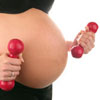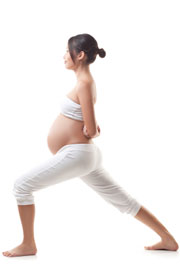- Introduction
- Exercise recommendations for sedentary women
- Exercise recommendations for active women
- Important tips
Introduction
Exercise is a safe and beneficial activity for pregnant women. There have been no studies that have substantiated previous views that exercise poses risks for mother and child in a healthy pregnancy. Exercise in pregnancy is not only essential for women who are already active and want to maintain their fitness level, but also for women who have never exercised before. If you are physically inactive you make like to view your pregnancy as a perfect time to make a healthy change to your lifestyle by introducing an exercise program, with the help of your doctor.
Whether or not you have been active prior to pregnancy, it is essential that you seek guidance about an appropriate exercise program from your doctor. Safe exercise guidelines are different depending on your medical condition and exercise experience, but all women will need to be aware of the impact of exercise on themselves, their foetus and their pregnancy. Through understanding the risks, the benefits, the recommendations and what to avoid, every woman can make informed decisions about her limits and aims for exercise during pregnancy.
More information on Exercises to Do and Avoid during Pregnancy.
Exercise recommendations for sedentary women

The second trimester is a perfect time to exercise under medical guidance as sickness and fatigue would have settled but the physical changes that limit the range of activities you can engage in (as is the case in the third trimester) have not set in. That said, studies on physically inactive women who embark on an exercise program at the beginning of their pregnancy have shown no adverse events. Therefore, if you feel up to it and your doctor has indicated that it is safe, then you can begin your program as soon as you like.
Under the guidance of your doctor you will need to slowly initiate your exercise program. If possible, starting with 15 minutes of continuous exercise three times a week is ideal. In cases where this is too strenuous, working up to 15 minutes in 5 minute sessions can be an alternative. Each week another 5 minutes should be added to the session until you can sustain 30 minutes of continuous exercise. Once you have achieved this comfortably then you can increase the number of sessions you do per week to most or all days of the week.
Good exercise suggestions for beginners include:
- Walking;
- Swimming; and
- Stationary cycling.
Exercise recommendations for active women

It is possible to engage in intense exercise but you should be very closely monitored by your doctor and be aware of the symptoms to monitor that may indicate that you are overdoing it.
More information on Exercise Safety Considerations during Pregnancy.
Important tips
All women, whether they are just beginning to exercise or are elite athletes need to take precautions to ensure they reduce the risk of injury and overheating.
You need to warm up for at least 5 – 10 minutes before engaging in any physical activity. Warming up can include slow walking and stretching. The walk will warm up the muscle and the stretches will help avoid any injury. Stretches should be held for at least 10 – 20 seconds.
More information on Warming up before Exercise.
During pregnancy joints are loose and more prone to injury and soreness. Therefore pregnant women especially, need to cool down and stretch once they have finished exercise. The cool down period also allows the heart rate to return to normal levels.

In periods of growth, you will have increased energy (food) requirements. Pregnancy is a period of growth for both the mother and the foetus, particularly in the second and third trimesters of pregnancy when foetal growth occurs most rapidly. Physical activity also increases energy requirements. It is important that pregnant women who engage in physical activity consume sufficient nutritional intake for a healthy pregnancy and foetal growth. The nutritional intake necessary will differ depending upon your individual characteristics, such as weight, height, age and your level of physical activity.
More information on Energy Expenditure.
More information on Nutrition in Pregnancy.
Exercise in comfortable, loose fitting clothing. This will help to keep you cool and will not reduce your range of motion during sports. It is important that pregnant women especially, invest in a good sports bra and supportive shoes with good grip to reduce the risk of falling.
More information
 |
For more information about pregnancy and exercise, including pre-pregnancy exercise, suitable types of exercise, risks and benefits of exercise and exercise myths, see Pregnancy and Exercise. |
 |
For more information about pregnancy, including preconception advice, stages of pregnancy, investigations, complications, living with pregnancy and birth, see Pregnancy. |
 |
For more information on fitness and exercise, including stretches, types of exercise, exercise recovery and exercise with health conditions, as well as some useful videos, see Fitness |
References
- Davies GAL, Wolfe LA, Mottola MF, MacKinnon C. Exercise in pregnancy and the postpartum period. Joint SOGC/CSEP Clinical Practice Guideline. 2003; 129: 1-7. [Full Text]
- National Collaborating Centre for Women’s and Children’s Health. Antenatal care: routine care for the healthy pregnant woman. Clinical Guideline March 2008 2nd ed. RCOG Press; London: 2008. [Full Text]
- Owe KM, Nystad W, Bo K. Correlates of regular exercise during pregnancy: the Norwegian Mother and Child Cohort Study. Scandinav J Med Sci Sport. 2009; 19(5): 637-45. [Abstract]
- Sydney South West Academy of Sport Policy Statement: Exercise During Pregnancy [online]. SWSAS [cited June 2010]. Available from: URL: http://www.swsas.org.au/documents/pregnancy%20and%20sport%20policy.pdf
- American Congress of Obstetricians and gynecologists: Exercise during pregnancy [online]. ACOG 2003 [cited June 2010]. Available: URL: http://www.acog.org/publications/patient_education/bp119.cfm
- Top recommended exercises [online]. American Pregnancy Association, 2008 [cited July 2010]. Available from URL: http://www.americanpregnancy.org/pregnancyhealth/toprecommendedexercises.html
- The Royal Australian College of General Practitioners: Weight problems and pregnancy [online]. RACGP, 2009 [cited July 2010]. Available from URL: http://www.racgp.org.au/familyhealth/Weight_problems_and_pregnancy_women
- Panel on Macronutrients & Standing Committee for the Scientific Evaluation of Dietary Reference Intakes. Energy. Chapter 5. Dietary Reference Intakes for Energy, Carbohydrate, Fiber, Fat, Fatty Acids, Cholesterol, Protein and Amino Acids (Macronutrients) [online]. National Academy of Sciences, 2020 [cited Jul 2010]. Available from: http://www.nap.edu/catalog/10490.html
- Panel on Macronutrients & Standing Committee for the Scientific Evaluation of Dietary Reference Intakes. Physical Activity. Chapter 12. Dietary Reference Intakes for Energy, Carbohydrate, Fiber, Fat, Fatty Acids, Cholesterol, Protein and Amino Acids (Macronutrients) [online]. National Academy of Sciences, 2020 [cited Jul 2010]. Available from: http://www.nap.edu/catalog/10490.html
- Department of Health and Ageing. Healthy eating at various life stages- pregnant women. 2009. [cited 2010, May 1]. Available from: http://www.health.gov.au/internet/healthyactive/publishing.nsf/Content/pregnant-women
All content and media on the HealthEngine Blog is created and published online for informational purposes only. It is not intended to be a substitute for professional medical advice and should not be relied on as health or personal advice. Always seek the guidance of your doctor or other qualified health professional with any questions you may have regarding your health or a medical condition. Never disregard the advice of a medical professional, or delay in seeking it because of something you have read on this Website. If you think you may have a medical emergency, call your doctor, go to the nearest hospital emergency department, or call the emergency services immediately.








